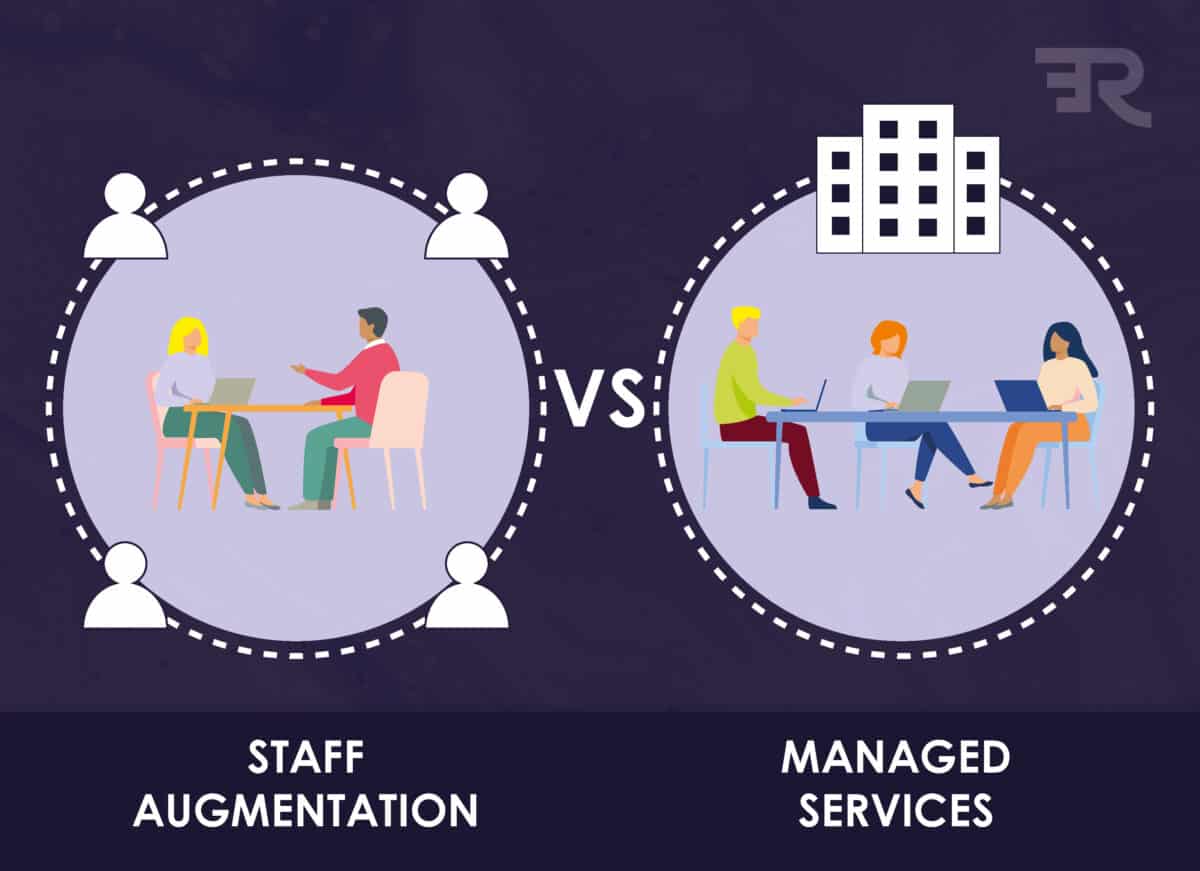
14 min read
IT Managed Services vs. Staff Augmentation — Your Best Choice
It’s time to wrap up the IT managed services vs. staff augmentation debate.
You know you need to accelerate your company’s digital transformation to keep up with the changing times. But putting together an IT team is not always easy, particularly one that meets your specific needs and requirements.
You also know you can turn to IT outsourcing for a solution and tackle a staff shortages issue. But it’s hard to stick firmly to this path when two attractive options are available. So, which one works for you? Should you go for managed services or staff augmentation?
We’ll help you answer that question by exploring the advantages and disadvantages of these two models.

Staff Augmentation and Managed Services: Pros and Cons
Top IT outsourcing solutions come with their benefits and drawbacks. The final choice will depend on your needs.
Managed services vs. staff augmentation — the case for managed services
To appreciate how managed services can benefit your company, you first need to understand its concept. Let us guide you through it.
What managed services mean
Managed service providers deliver IT services alongside ongoing administration and support. This option is often preferable for most companies willing to take a hands-off approach to IT operations and focus on core business.
Benefits of managed services
Let’s consider the upsides of choosing managed services.
Predictable expenses
Managed services company offers payment plans that cover almost all the expenses of your IT teams. This means you will pay a fixed monthly or annual fee without surprise bills. Meanwhile, if you manage your IT teams independently, overtime pay, repairs, and other unexpected expenses become your responsibility.
Working with managed service providers also translates to reduced cost, as you benefit from economies of scale. That is, your provider has enough resources to cover expensive software and equipment since they work with multiple clients.
Scalability
Managed service providers are well-equipped to scale your operations. They can easily accommodate extra equipment, software, and staff. And you can scale down just as easily once you no longer need them.
Scaling is less doable if you manage your own IT teams. Recruitment alone might cut a huge chunk off your budget. Throw in the hardware and software costs, and you’re well on your way to burning through your budget.
Minimal downtime
Managed service providers run several teams and have extra equipment to prevent downtime and quickly fix problems as they come up. Businesses that run their own IT teams and systems are rarely as well-equipped to handle server failures, hardware issues, and cyberattacks.
Experienced professionals
Recruiting and training software developers is a long and expensive process that doesn’t always result in an effective team being assembled. The only way to ensure you have the right talent is by seeing them in action. Managed services allow you to work with teams that have already proven their worth. And if anyone fails to live up to your expectations, the provider can choose another professional from their talent pool.
Greater focus on core offerings
As we said, entrusting an outsourced team with IT management, lets you focus on your core business. You can double down on improving your product, revving up marketing campaigns, and bolstering sales, while the managed service provider maintains your IT systems.
Managed services are a smart option if you consider handing over IT operations management to an outsourcing company.
Drawbacks of managed services
Here is a list of disadvantages you might want to consider before signing a deal with the managed service provider:
Lack of physical presence
Working with managed service providers means you will have no IT personnel present on-site. This might be a trouble if an urgent issue comes up. Nothing beats calling IT support and having them show up physically right then and there.
Disconnect between business and IT
Managed service providers work with multiple clients at any given time. This makes it harder to develop a meaningful relationship with your business and gain a deeper understanding of what you do. When project managers or tech leads aren’t your in-house specialists, you might fear losing control of the steering wheel. And for a reason. Effective engineering team leadership does require a perfect understanding of a company’s inner workings.
Limited scope
Managed service providers don’t cover all areas of technology. Too often, clients are stuck with limited offerings and cannot ask for anything beyond that. The provider informs them about their tech stack and supported apps from the get-go. And they must accept their way of doing things.
Failure to build your own processes and knowledge bank
Companies that outsource IT operations miss the opportunity to build unique processes and knowledge banks that grow in value over time. They miss out on strategic resources that could take their business to the next level.
Vendor lock-in
When building a specific solution through IT managed services, contrary to staff augmentation service, it can be challenging to avoid the vendor-lock-in phenomenon. Organizations relying solely on one external team with their technological expertise, workflows, tools, and more will find it harder to migrate to another outsourcing provider or assemble an in-house team and switch to another staff augmentation model.
Vendor lock-in is an acute business threat. It might entail such unwelcome outcomes as lack of service diversity, ineffective problem management, or even business continuity risk. Your task as a business leader is to remain flexible and avoid getting locked into one vendor and the only path dependence.
Security concerns
Working with managed service providers often entails sharing sensitive data and proprietary information. This poses security concerns. Some companies, especially if it’s an IT organization, limit the information they share, which keeps the development process from reaching its full potential.
Do the benefits outweigh the drawbacks, you wonder? The answer depends on your company’s circumstances.
Staff aug vs. managed services — a spotlight on staff augmentation
Now it’s time to learn more about staff augmentation and when it might be the right solution for you. Let’s start with the definition.
What staff augmentation means
Staff augmentation allows companies to fill resource gaps in their tech teams with specialized skills and talents provided by an external hiring partner. Hires are onboarded to implement business ideas and meet specific project needs with the right technological expertise.
Businesses that choose staff augmentation have an in-house IT team that takes in external hires and assumes responsibility for managing them. This outsourcing strategy lets you scale your teams up or down easily as needed.
Benefits of IT staff augmentation
So, what advantages will compel you to go for staff augmentation? Here are a few to consider:
Access to a rich talent pool
Instead of upgrading your employees’ tech skills, you can hire professionals with the specific advanced skills you seek. You can tap into the provider’s talent pool and hire new employees with narrow expertise. Hiring platforms like Expert Remote have a rigorous vetting process that helps ensure you won’t be wasting your time with an incompetent employee. They also have an array of domain-centric talents, so you are sure to find just the specialist you need.
Scalability
With access to a rich talent pool, scaling your operations will be quick and easy. You won’t have to deal with a lengthy and costly recruitment process to get sought-after talents. And you can scale up or down as needed since staff augmentation offers flexible terms. You can hire an external expert only for the duration of the project or the validation of a particular business goal.
Cost effectiveness
You can save a lot by hiring temporary staff. Staff augmentation is even more cost-efficient as you won’t have to invest in recruitment. Neither will you shoulder the burden of productivity loss or opportunity cost, as you can save time by quickly hiring just the expert you need. What’s most important, you can save this much without compromising quality.
New perspective
Adding someone outside your company to your in-house team can bring a new perspective that could shake up the way things are done. They can offer an impartial attitude towards the project execution and the ways to improve it. And since they are not bogged down in office politics, they won’t have pre-existing loyalties that engender biased opinions.
Greater transparency and control
Outsourcing the entire IT team may strip you of agency over the development process. This poses challenges to quality control. Your project management style may also differ from that of the outsourcing company, creating barriers to communication and collaboration. Your outsourcing contractor may even keep you out of the development altogether.
With staff augmentation, you benefit from an external talent pool and maintain complete control over your IT operations. You’ll have more confidence in your project as you are fully aware of how it goes at any point in time.
Disadvantages of staff augmentation
Even great solutions have their drawbacks. Here are a few to consider:
Onboarding complexities
Although staff augmentation takes away recruitment pains, you still have to deal with onboarding complexities. And this eats into HR and managerial hours.
You’ll have to introduce external hires to your business rules, in-house workflows, technical tools, work culture, and ongoing projects. A good workaround is to create demos and guides that you can easily update and reuse for every hired season.
Lack of project-specific knowledge
The external hires may be well-versed in their areas of expertise but might need to catch up on project-specific knowledge. The problem worsens when the company’s project manager and IT staff have trouble communicating their processes and needs.
You can avoid this by offering extra onboarding training to a new team member of the entire team. It also helps to provide collaboration tools to streamline communication, workflow, task assigning, scheduling, monitoring, and assessment.
Greater management burden
Managing outstaffed employees is rarely a hassle. But they still add to the management burden in terms of oversight and accountability. Project managers must also adjust all the processes to accommodate the new hire. The load will be lighter if your managers are skilled at coordinating the development team, processes, and resources remotely.
Higher-than-expected costs
Staff augmentation is more cost-effective overall than managed services, but costs can increase if the project runs longer than expected. Though, you can shield your company from this issue by discussing it with your service provider in advance as well as establishing adequate project management and estimation processes.
Do you still hesitate about the right outsourcing solution for your company? Let’s explore the topic in more detail in the next section.
IT Managed Services vs. Staff Augmentation: What Works for You
The one-size-fits-all solution does not exist. There is only the right solution for your company — one that meets its unique needs and requirements. Let’s answer a few questions to figure out the proper option for you.
| Do you need a solution for a specific project or for company-wide IT requirements? | Companies that prefer to outsource the whole IT project go for managed IT services. They rely on a third-party company to run their tech operations and even some routine tasks. Staff augmentation works best for businesses with an in-house IT team that needs additional staff to fill a skill gap for specific projects. |
| Are you looking for a short-term or long-term partnership? | Managed services provider typically handles the company’s IT operations for long-term projects, forging years-long partnerships.Meanwhile, you need staff augmentation for as long as your project lasts, usually as a temporary solution. |
| What degree of control are you comfortable with? | Staff augmentation means bringing in an employee you’ll have to supervise and take accountability for. A bigger responsibility also means greater control over their work progress and output.With managed services, on the other hand, you pass the managerial burden to the provider. The caveat is that you get limited control over the process and may not like the provider’s way of doing things. And you have limited control over the end product until the project completion. |
A major reason for choosing managed services is that it allows companies to focus on their core business. The catch is that IT operations have long become integral to these core offerings. These days, in most cases, the smartest choice is to keep an in-house IT team and bring in additional staff when necessary.
At Expert Remote, we found that nine out of ten clients would rather interact directly with the tech staff and prefer to manage their own tech teams.

Conclusion
Both managed services and staff augmentation have benefits that could take your business to the next level. But each option has its drawbacks that might trigger a lot of hassles. The wisest course of action would be to carefully weigh the pros and cons and choose staff augmentation model tailored to your project, business needs, and management style.
And once you are ready to search for the best professionals, we will be happy to connect you with our carefully vetted talents. Reach out to us at Expert Remote to learn more.
Remote tech teams & the future of work blog
Remote tech teams & the future of work blog
Your form has been successfully submitted.

